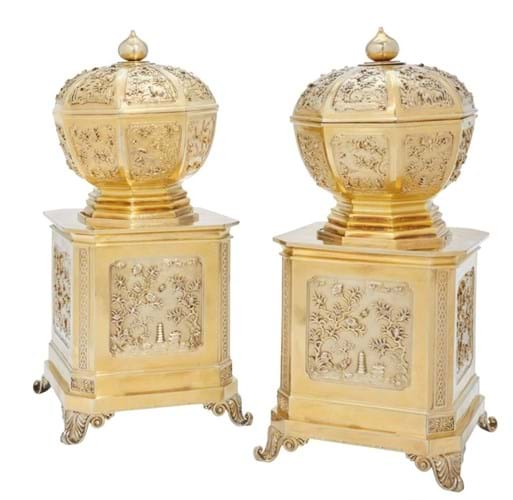
A silver-gilt chinoiserie garniture combining a single Chinese octagonal bowl and cover, c.1730, with a matching bowl and a pair of silver gilt plinths made almost a century later by Paul Storr. It sold for £190,000 at Christie’s.
It combines a single Chinese octagonal bowl and cover, c.1730, with a matching bowl and a pair of silver gilt plinths made almost a century later by Paul Storr (London 1810). Together they stand 15in (38cm) high and weigh 227oz.
Working for the retailer Rundell, Bridge & Rundell, Storr made a fine copy of the Chinese exemplar, replicating its onion-shaped finial and the chased decoration of figures in landscapes with birds, animals and flowers. The plinths are engraved with a coat-of-arms for Thomas Reynolds Moreton, 4th Baron Ducie, later 1st Earl of Ducie (1776-1840), and his wife Lady Frances Herbert, daughter of Henry Herbert, 1st Earl of Carnarvon, whom he married in 1797.
The bowl has a more exotic history than most Chinese export silver which arrived directly in Britain on East India Company ships. As suggested by the inscription This Font was taken from the Cathedral Church of Lima, it had made its way to the Spanish colonial viceroyalty of Peru before it came to be in the London workshops of the royal goldsmiths.
Owned by the 4th Baron Ducie from the early 19th century, the garniture was passed by descent to the 6th Earl before they were sold at Christie’s in 1959 (£360) and at Sotheby’s in 1964 (£2800).
Acquired by the owner’s family from Thomas Lumley, London, they were consigned to the Christie’s London online sale The Collector from outside the UK and accordingly incurred an extra 5% import duty on the hammer price.
Chinese export silver from the early 18th century is much scarcer than its 19th century equivalent. Around £50,000-80,000 was expected for this lot but when bidding closed on February 8 it had reached £190,000 (plus 25% buyer’s premium).














